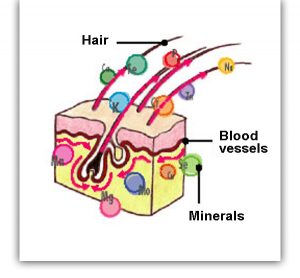Minerals are essential for growth, healing, vitality and well-being. They provide structural support in bones and teeth, and they maintain the body’s acid-base balance, water balance, nerve conduction, muscle contractions and enzyme functions. Minerals participate in almost every metabolic process in the body – they are the true ‘spark-plugs’ of life. Ideally we should get all the minerals we need from a balanced diet. Unfortunately this is rarely possible in today’s world. Modern farming techniques, fertilizers and depleted soils reduce the mineral content of foods. Environmental toxins, chemical food additives and stressful lifestyles also have a detrimental effect on our nutritional status. Consequently, we need to test and monitor our nutritional needs more than ever.
Hair analysis
What is a Hair Tissue Mineral Analysis?
Hair Tissue Mineral Analysis (HTMA) is an analytical test that measures the mineral composition of hair. It is regarded by many doctors, naturopaths and nutritional therapists as one of the most valuable screening tools available in everyday and preventative health care. Budalab provides reliable clinical data on over 35 nutrient and toxic minerals, and over 26 significant mineral ratios.
Hair is used for mineral testing because of its very nature. Hair is formed from clusters of specialized cells that make up the hair follicle. During the growth phase the hair is exposed to the internal environment such as blood, lymph and extra-cellular fluids. As the hair continues to grow and reaches the surface of the skin its outer layers harden, locking in the metabolic products accumulated during the period of formation. This biological process provides a blueprint and lasting record of mineral status and nutritional metabolic activity that has occurred during this time.
The precise analytical method of determining the levels of minerals in the hair is a highly sophisticated technique: when performed to exacting standards and interpreted correctly, it may be used as a screening aid for determining mineral deficiencies, excesses, and/or imbalances. HTMA provides you and your health care professional with an economical and sensitive indicator of the longterm effects of diet, stress, toxic metal exposure and their effects on your mineral balance that is difficult to obtain through other clinical tests.

NUTRITIONAL ELEMENTS:
Boron, Calcium, Chromium, Cobalt, Copper, Iron, Magnesium, Manganese, Molybdenum, Phosphorus, Potassium, Selenium, Sodium, Sulfur, Zinc
MINERALS TESTED
TOXIC ELEMENTS:
Aluminium, Antimony, Arsenic, Beryllium, Cadmium, Lead, Mercury, Uranium
ADDITIONAL ELEMENTS
Barium, Bismuth, Germanium, Lithium, Nickel, Platinum, Rubidium, Strontium, Thallium, Tin, Titanium, Tungsten, Vanadium, Zirconium
WHY TEST FOR MINERALS?
WHY NOT TEST BLOOD?
Blood analysis for minerals is a good indicator of the transport of minerals to and from the storage areas of the body (extracellular).
Hair tissue mineral analysis is a good indicator of the metabolic processes occurring within the cells (intracellular).
Measuring the mineral content of blood gives a good indication of the minerals being transported around the body. However, it can not accurately measure the minerals stored in tissue. Very often, the body’s homeostatic mechanisms maintain proper serum mineral concentrations at the expense of tissue concentrations. Unfortunately, correct serum levels often mask both mineral excesses and deficiencies in tissue mineral concentrations.
For example:
■ About 30-40 days after acute lead poisoning, elevated serum lead levels may be undetectable. This is because the body removes lead from the blood as a protective measure and deposits it into tissues such as the liver, bones, teeth and hair.
■ Iron deficiency symptoms are present long before low serum iron levels are detected, because the body depletes stored iron in order to maintain normal serum iron levels. Note: HTMA should be used in conjunction with other appropriate pathology tests for the most comprehensive picture of a person’s health.
■ Only 1 percent of magnesium in the body is distributed in the blood, making a simple sample of magnesium from a serum magnesium blood test not very useful. Most magnesium is stored in the bones and organs, where it is used for many biological functions. Yet, it’s quite possible to be deficient and not know it, which is why magnesium deficiency has been dubbed the “invisible deficiency.

Why biopsy hair tissue?
Hair is a body tissue made up of mostly dead, keratinised cells fused together. The shaft of the hair is the portion that projects from the skin surface. The root of the hair, below the skin surface, contains living matrix cells from which the hair grows. Matrix cells depend on the blood supply for nourishment and growth. As they grow and divide, minerals are keratinised into the growing hair shaft, creating a permanent record of metabolic activity and exposure to toxic elements. Mineral concentrations in the hair can provide a reliable indicator of mineral stores in the whole body. If your health, diet or environment has created a mineral imbalance or toxic mineral excess, it will be recorded in the hair shaft. Research has shown that hair mineral levels reflect stored mineral levels in other body tissues.
Non-intrusive health screening
Hair Tissue Mineral Analysis is a non-intrusive health screening tool for measuring your body’s mineral status. This data can highlight potential health problems and help you to treat them through a nutritional program designed to meet your individual health needs.
Hair samples
The laboratory requires 125 milligrams (0.125 g) or about one tablespoon of head hair for testing. Taking a hair sample is quick and easy. Cut hair close to the scalp. Use the first 4cm of hair, as this reflects the body’s most recent metabolic activity. The hair needs to be clean, well-rinsed, untreated and uncolored. If hair is treated or colored, wait six to ten weeks and take a sample from the freshly grown untreated hair. Head hair is best for testing. If head hair is not available, beard or pubic hair can be used. If there is no hair, clean fingernail clippings can be tested. These alternative tissue samples can be used to monitor toxic mineral levels, but may not always provide nutrient mineral data that is as reliable as head hair. Do not mix different types of tissue samples, eg. head hair with pubic hair.
CONDITIONS AFFECTED BY MINERAL IMBALANCES
Acne
Allergies
Alzheimer’s disease
Anemia
Anxiety
Arthritis
Atherosclerosis
Cardiac conditions
Dental problems
Depression
Diabetes
Digestive problems
Fatigue
Hair loss and poor nails
Headaches
High blood pressure
Hormone imbalance
Hyperactivity
Hypercholesterolemia
Hypoglycemia
Immune impairment
Infertility
Insomnia
Learning difficulties
Macular degeneration
Memory problems
Migraines
Mood swings
Muscle cramps
Osteoporosis
PMS
Prostate disorders
Skin problems
Stress
Thyroid disorders
Wounds healing poorly


Causes of mineral imbalances
Fad diets and diets high in refined carbohydrates, sugar, salt, alcohol and saturated fats can lead to mineral deficiencies and excesses. Even the mineral content of a healthy diet can be deficient if foods are grown on nutrient-poor agricultural lands.
Both physical and emotional stress can lead to mineral imbalances. B-complex vitamins, zinc and magnesium are lost in greater quantities when you are stressed; you also absorb less nutrients from your food. Sports people often have a higher requirement of certain nutrients.
Many deplete the body’s store of nutrient minerals and can increase levels of toxic minerals. Medications such as diuretics, the oral contraceptive pill, antacids and aspirin can all cause vitamin and mineral deficiencies.
Toxic minerals such as lead, mercury and cadmium can interfere with mineral absorption and increase mineral excretion. They build up in our bodies from sources such as: air pollution, car exhaust, cigarette smoke, unfiltered water, dental amalgams, copper and aluminium cookware, hair dyes and antiperspirants. Toxins have also entered the food chain, contaminating some of our foods. It is almost impossible these days to avoid some exposure to toxic minerals.
A predisposition towards certain mineral imbalances, deficiencies and excesses can be inherited from parents. Certain individuals can also inherit a higher requirement than normal for particular nutrients to maintain good health.
Supplements can also lead to mineral excesses and deficiencies. For example, excess calcium intake can cause phosphorus and magnesium deficiency. Continued magnesium deficiency increases sodium levels and eventually causes vitamin A deficiency.
